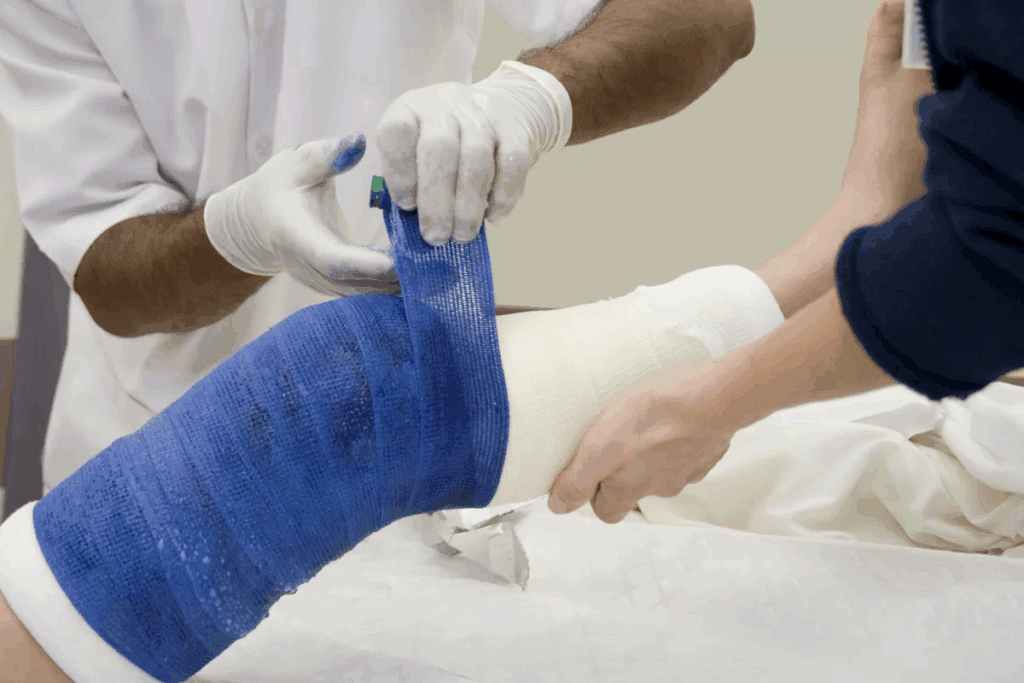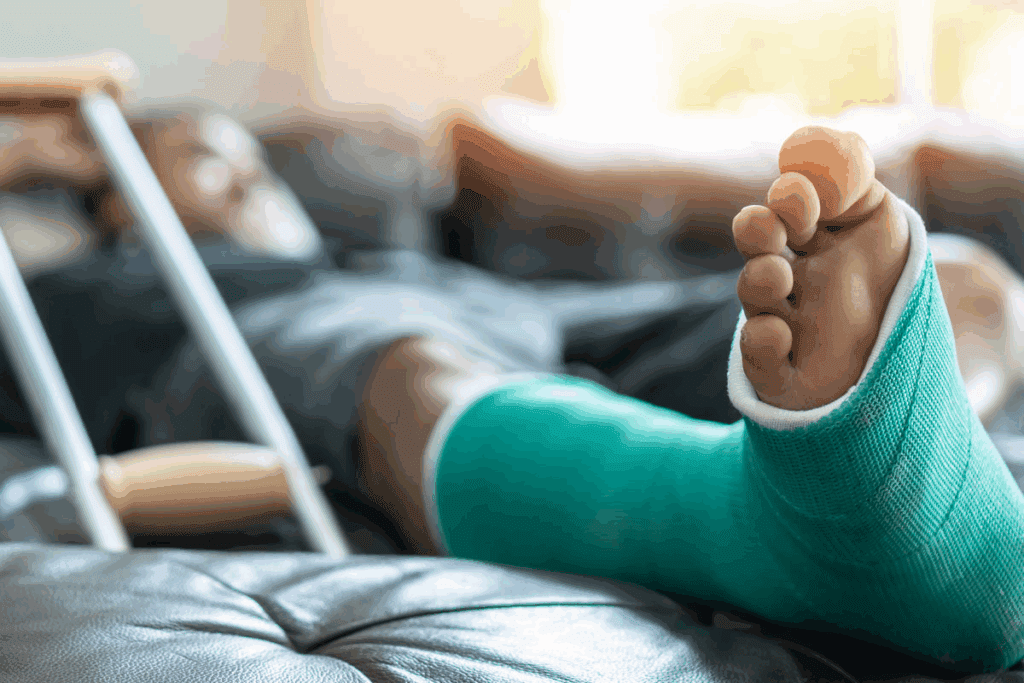Last Updated on November 4, 2025 by mcelik

Healing a fracture is a complex process with several stages. Knowing these stages is key to a faster recovery.
The body can naturally heal bone fractures with the right care. Nutrition, age, and fracture severity all affect how fast you heal.
Improving bone healing can prevent complications and help you move better sooner. This article will cover important factors and tips for faster healing.
To heal a bone fracture fast, it’s key to follow your doctor’s advice. The fastest way to heal a broken bone is to closely follow the instructions your doctor gives you. This shows how important it is to know how bones heal to recover well.
Bone healing has four stages: inflammation, soft callus, hard callus, and remodeling. Each stage is vital for the bone to regain its strength and function.
The time it takes for a fracture to heal varies. It depends on the fracture’s severity, age, and health. Most fractures heal in 6 to 12 weeks, but some may take longer.
| Fracture Type | Typical Healing Time |
| Simple fractures | 6-8 weeks |
| Complex fractures | 12-16 weeks |
| Comminuted fractures | 16 weeks or more |

Many things can affect how fast a bone heals. Nutrition, immobilization, age, and health are key. Eating enough calcium and vitamin D is important. Also, not putting too much stress on the fracture is vital.
Knowing these factors and the healing stages helps people recover better. Following medical advice and staying healthy is key.
For bones to heal well, we need a diet full of important nutrients. These include calcium, vitamin D, and other key elements. Eating a balanced diet helps bones fix themselves after a fracture.
Calcium is key for strong bones. It helps bones grow back after a break. We should eat foods high in calcium, like dairy, leafy greens, and fortified foods.
Adults need about 1,000 mg of calcium every day. If we don’t get enough from food, we might need supplements.
Vitamin D helps our body use calcium. It’s important for bones to stay healthy. We can get vitamin D from sunlight, fatty fish, and some dairy products.
Some people might need vitamin D supplements, like those who don’t get enough sun. Adults should aim for 600-800 IU daily.
Vitamin K2 helps bones by working with calcium. It’s in foods like cheese and natto, and some supplements.
Magnesium is also important for bones. It helps with calcium use and vitamin D work. It’s found in many foods.
Eating the right mix of these nutrients is key for bone healing. Here’s a table with the daily amounts and where to find them:
| Nutrient | Recommended Daily Intake | Food Sources |
| Calcium | 1,000 mg | Dairy products, leafy greens, fortified foods |
| Vitamin D | 600-800 IU | Fatty fish, fortified dairy products, sunlight exposure |
| Vitamin K2 | Varies | Fermented foods (cheese, natto), supplements |
| Magnesium | 400-420 mg for men, 310-320 mg for women | Nuts, seeds, whole grains, dark leafy greens |
Adequate protein intake is vital for bone healing. It supports the body’s natural repair processes. Protein provides essential amino acids for new bone tissue, making it key for fracture recovery.

A high protein diet promotes bone healing by providing necessary building blocks. Increasing protein intake can speed up recovery, lowering complication risks and improving outcomes.
Studies show a protein-rich diet boosts bone density and fracture resistance. It also supports the bone healing process.
Collagen peptide supplements are known for supporting bone health and forming bone matrix. They contain hydrolyzed collagen, packed with amino acids like glycine, proline, and hydroxyproline.
Using these supplements may stimulate bone growth, improve density, and enhance healing.
Fracture patients should eat protein-rich foods like lean meats, fish, eggs, dairy, and plant-based options. Including a mix of these sources ensures enough protein.
While protein is key for bone healing, balancing it with other nutrients is also important. A diet rich in vitamins and minerals like calcium, vitamin D, and magnesium is vital for bone health.
Getting enough of these nutrients supports bone healing, lowers complication risks, and promotes well-being.
Some fatty acids and micronutrients are key for fixing bones. Eating the right mix of these can really help bones heal faster.
Omega-3 fatty acids, like EPA and DHA, are important for lessening inflammation. This is important when bones start to heal. Eating foods high in omega-3s, like fish and nuts, can help a lot.
Zinc, copper, and silicon are important for bone growth. Zinc helps with making proteins and cells. Copper is key for connective tissue. And silicon helps bones get stronger. Eating a variety of foods, like meats and grains, can give you these nutrients.
Antioxidants, like vitamins C and E, fight off damage and help healing. They keep the body healthy during recovery. Eating lots of fruits and nuts can give you enough antioxidants.
To get the right nutrients, think about your whole diet, not just one thing. Eating a variety of foods, like proteins and veggies, is best. Talking to a dietitian can help make a plan that’s just right for you.
Healing a fracture often needs a mix of medical treatments and following doctor’s orders. The main aim is to heal the bone fast and well. This helps get back to normal and eases pain.
Keeping the bone in place is key for healing. This is done with casts, splints, or braces. They hold the bone pieces together for natural healing. The right choice depends on the fracture’s type and where it is.
Sticking to the doctor’s plan is essential for a good recovery. This means going to check-ups, taking meds, and not doing things that might slow healing.
Some meds help bones heal by boosting the body’s repair work. These can include drugs that help bones grow or lessen swelling.
Sometimes, surgery is needed to speed up healing. Surgery can line up bone pieces, stabilize the fracture, or fix problems that slow recovery.
Bone stimulation therapies are a big step forward in treating fractures. They help the body heal faster and more effectively.
LIPUS is a non-invasive therapy that boosts bone growth and healing. It sends out low-intensity ultrasound pulses to help repair bones.
Key benefits of LIPUS include:
Electrical bone stimulation uses electrical currents to help bones grow and heal. It can be applied in different ways, depending on the method.
Types of electrical bone stimulation include:
PEMF therapy uses electromagnetic fields to help bones heal. It stimulates cellular processes and promotes bone repair.
Research on PEMF has shown:
Many studies have looked into the benefits of bone stimulation therapies. LIPUS, electrical bone stimulation, and PEMF have shown promise in healing fractures.
Key findings from research include:
| Therapy | Effectiveness | Notable Benefits |
| LIPUS | Accelerates healing | Non-invasive, minimal side effects |
| Electrical Bone Stimulation | Stimulates bone growth | Can be invasive or non-invasive |
| PEMF | Enhances bone density | Reduces pain and inflammation |
Recovering from a fracture is more than just resting the broken area. Physical therapy plays a key role in getting back to normal. It helps restore function and strength. After a fracture, the body heals, but it’s also important to keep or regain muscle and joint strength.
The right time to start physical therapy varies. It depends on the fracture’s type and severity, and the person’s health. Physical therapy usually begins when the initial healing starts and the doctor says it’s okay. Early movement helps avoid stiffness, boosts blood flow, and aids healing.
Range of motion exercises are vital for keeping the affected area flexible and avoiding stiffness. These exercises are customized based on the fracture type and recovery stage. For instance, after a wrist fracture, patients might start with simple wrist rotations and flexions.
A graduated exercise program gets progressively harder as you move through recovery. It strengthens muscles around the fracture, improves bone density, and boosts functional ability.
| Recovery Phase | Exercise Intensity | Examples of Exercises |
| Initial Healing (0-6 weeks) | Low | Gentle range of motion, isometric exercises |
| Strengthening (6-12 weeks) | Moderate | Resistance band exercises, light weight training |
| Advanced Strengthening (3-6 months) | High | Progressive resistance exercises, functional training |
Working with a physical therapist is key for the best fracture recovery. They create a tailored exercise plan, track progress, and adjust as needed. They also teach proper technique to avoid injury and ensure a safe return to activities.
By adding physical therapy to your recovery plan, you can greatly improve your healing. You’ll regain strength and mobility, and lower the chance of future fractures.
Doing weight-bearing activities is key for strong bones and healing fractures. These activities, like walking or dancing, help bones grow and get denser. This is vital for bone health.
Weight-bearing exercises make bones grow new tissue. This is thanks to cells called osteoclasts and osteoblasts. Osteoclasts break down old bone, while osteoblasts build new one.
Mechanotransduction turns mechanical forces into signals that help bones. This complex process boosts bone density through various signaling pathways.
It’s important to follow safe weight-bearing plans for healing. The type and location of the fracture decide the plan. For example, lower limb fractures might start with no weight-bearing and then progress.
| Fracture Type | Initial Weight-Bearing Status | Progression |
| Lower Limb Fracture | Non-weight-bearing | Gradual progression to partial and full weight-bearing |
| Upper Limb Fracture | Often non-weight-bearing initially | Progress to weight-bearing as healing permits |
| Vertebral Fracture | Non-weight-bearing or limited weight-bearing | Careful progression under medical supervision |
Going from partial to full weight-bearing should be based on pain and healing. It’s important to watch for pain and adjust activities to avoid too much strain.
Pain monitoring is key in this process. If pain gets worse, you might need to go back to a lighter weight-bearing activity.
It’s important to listen to your body when doing more activities. Changing activities based on pain helps the healing process.
Recovering from a fracture needs a good plan for resistance and strength training. This kind of training is key to making bones stronger. By doing the right exercises, people can help their bones heal faster.
Resistance training helps a lot when you’re getting over a fracture. It makes bones denser and muscles stronger. Key benefits include:
It’s important to do safe and effective strength training while healing. Low-impact exercises are best to avoid too much stress on the bone. Examples include:
At home, you can use different tools and methods for strengthening. Resistance bands and light dumbbells are good because they’re easy to use and safe. Key techniques include:
| Equipment | Techniques | Benefits |
| Resistance bands | Band-based exercises | Portable and versatile |
| Light dumbbells | Weightlifting exercises | Improves muscle strength |
| Bodyweight | Bodyweight exercises | No equipment needed |
It’s important to slowly increase how hard and long your workouts are. This keeps challenging your muscles and bones, helping them get stronger. Guidelines include:
Getting better from a fracture is more than just doctor visits. It’s about making lifestyle changes too. By focusing on the right lifestyle habits, people can heal faster and get back to their daily life sooner.
Rest and recovery are key for the body to fix fractures well. When we rest, our body fixes and grows new tissues, like bone. Getting enough sleep and not pushing too hard are important parts of resting well.
Tips for Adequate Rest:
Too much stress can slow down healing. Using stress management methods can help.
Effective Stress Management Techniques:
Smoking and drinking too much alcohol can really slow down healing. Smoking cuts down blood flow to bones, and alcohol makes it hard for the body to take in important nutrients.
| Substance | Impact on Healing |
| Smoking | Reduces blood flow, slows healing |
| Alcohol | Interferes with nutrient absorption, impairs healing |
Keeping a healthy lifestyle during recovery means eating right, exercising (if your doctor says it’s okay), and drinking lots of water. A healthy lifestyle helps your body heal naturally.
Key Components of a Healthy Lifestyle During Recovery:
Healing from a fracture needs a detailed plan. This plan should cover nutrition, exercise, and medical care. By using a mix of these strategies, you can heal faster and get back to your activities sooner.
A good plan for healing includes a healthy diet and exercise. It also means following your doctor’s advice. Nutritional support is key, focusing on calcium, vitamin D, and protein for bone repair.
Everyone heals differently. A personalized healing plan meets your unique needs. Consider your age, health, and fracture severity when making this plan.
| Component | Description | Benefits |
| Nutritional Support | Adequate intake of calcium, vitamin D, and protein | Enhances bone regeneration and strength |
| Physical Therapy | Gradual exercise and mobility programs | Improves range of motion and reduces stiffness |
| Medical Interventions | Adherence to prescribed medications and treatments | Supports optimal healing and minimizes complications |
It’s important to check how you’re healing regularly. By tracking progress, you can adjust your healing plan as needed. This helps you stay on track with your recovery.
Working with your healthcare team is key to healing. By working closely with your healthcare team, you get the best care. They guide you through your recovery.
Recovering from a fracture can be tricky. Some common errors can slow down the healing. Knowing these mistakes is key to a quick recovery.
One big mistake is pushing too hard or coming back to activity too soon. This can stress the healing bone, leading to injury or more problems.
Consequences of Overexertion:
It’s important to listen to your doctor about how active you should be. Slowly increase your exercise to avoid overdoing it.
A bad diet can hurt fracture healing. Foods rich in calcium, vitamin D, and protein are vital for bone repair.
| Nutrient | Role in Bone Healing | Food Sources |
| Calcium | Essential for bone regeneration | Dairy products, leafy greens |
| Vitamin D | Facilitates calcium absorption | Sunlight exposure, fortified foods |
| Protein | Building blocks for bone repair | Meat, fish, eggs, legumes |
Seeing your doctor regularly is important. It helps track your healing and catch any problems early.
Benefits of Consistent Follow-Up:
Pain is a big clue about how your body is healing. Ignoring it can cause more harm.
Actions to Take:
By avoiding these mistakes and taking action, you can help your fracture heal faster. This reduces the chance of complications and gets you back to health sooner.
Healing from a fracture is complex and needs a mix of strategies for the best results. By using nutrition, exercise, and medical care, people can help their bones heal faster and get stronger.
It’s important to eat foods rich in calcium, vitamin D, and protein for bone repair. Also, doing physical therapy and exercises that make you use your bones can help make them stronger.
Doctors also have ways to help bones heal, like using casts or special treatments. By combining these methods, people can make a plan that works just for them.
Using a complete plan for healing fractures can make recovery faster and safer. It helps people get back to their usual lives sooner and with more confidence.
For bone repair, you need calcium, vitamin D, vitamin K2, and magnesium. These nutrients are key for bone health.
Eating enough protein helps bones heal. It gives bones the materials they need to mend. Collagen peptides also help build bone matrix.
Omega-3 fatty acids reduce inflammation. This helps create a better environment for bone healing.
Therapies like Low-Intensity Pulsed Ultrasound (LIPUS) and Pulsed Electromagnetic Field Therapy (PEMF) help bones grow. They speed up healing by stimulating bone repair.
Weight-bearing exercises are vital for bone health. They stimulate bone growth and strengthen bones. It’s important to follow safe exercise plans to avoid injury.
Resistance training boosts bone density by promoting bone growth. It also increases muscle mass, which supports bone health.
Rest, stress management, and avoiding harmful substances like smoking and alcohol are key. A healthy lifestyle aids in healing.
A mix of nutrition, exercise, and medical care can help. Creating a personalized plan and working with a healthcare team speeds up healing.
Mistakes like overexertion, not getting enough nutrients, and ignoring pain can slow healing. Not following up with doctors also hinders recovery.
Physical therapy, like range of motion exercises, can greatly aid recovery. It’s best to start when a physical therapist advises, following a graduated program.
Correct immobilization is essential for healing. It ensures the fracture heals right, reduces complications, and aids in a smooth recovery.
Subscribe to our e-newsletter to stay informed about the latest innovations in the world of health and exclusive offers!